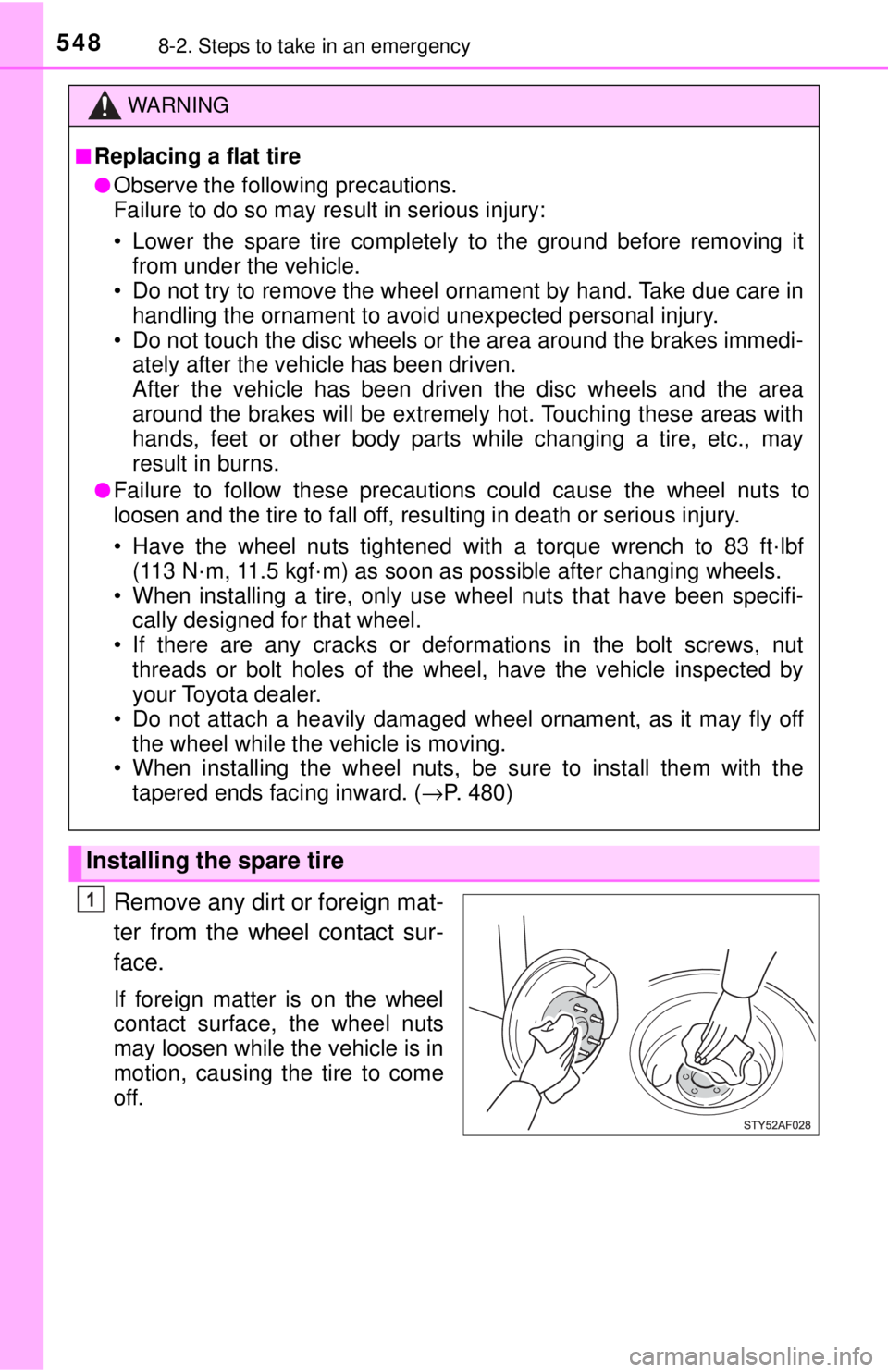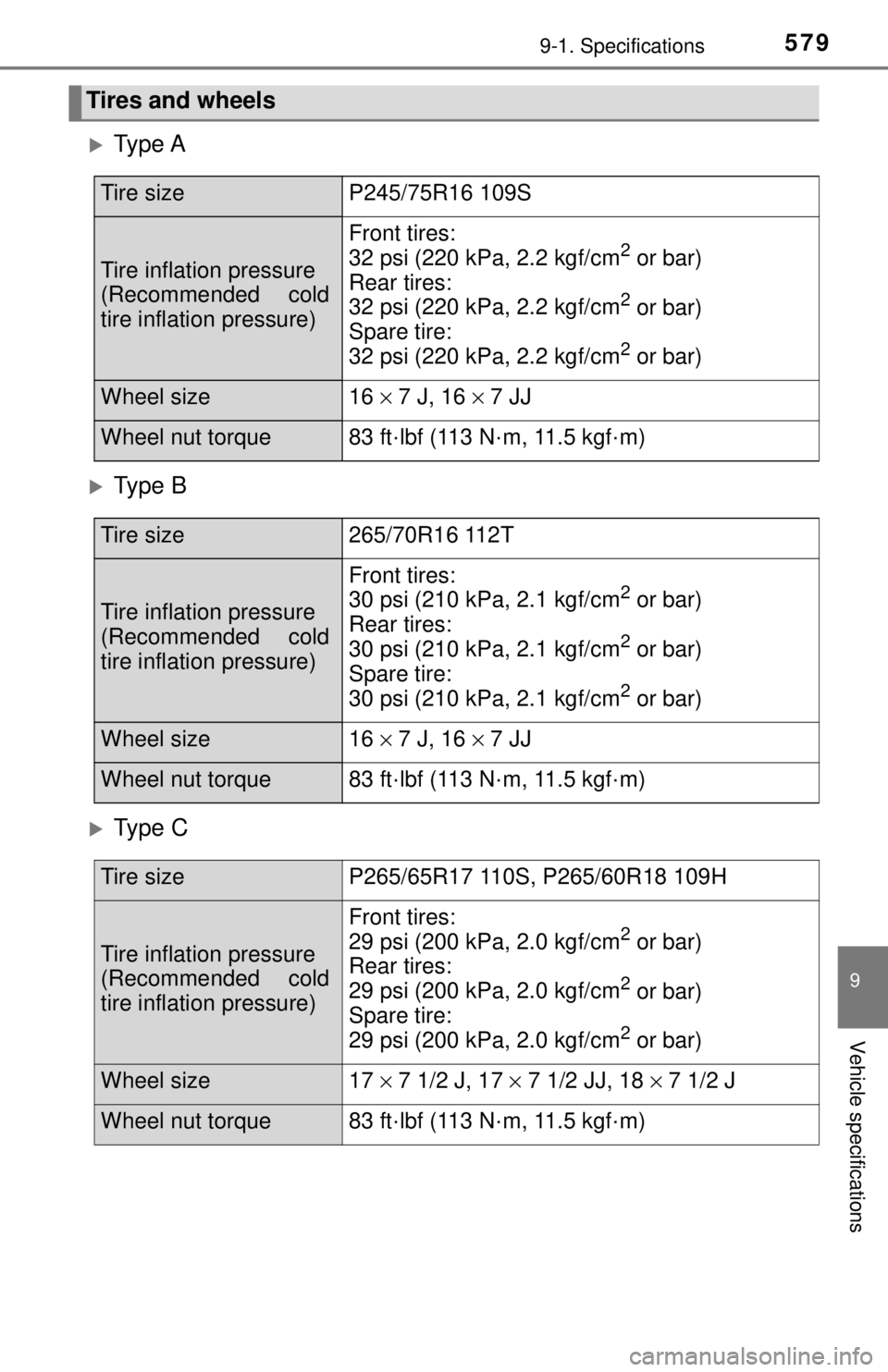Page 548 of 640

5488-2. Steps to take in an emergency
Remove any dirt or foreign mat-
ter from the wheel contact sur-
face.
If foreign matter is on the wheel
contact surface, the wheel nuts
may loosen while the vehicle is in
motion, causing the tire to come
off.
WARNING
■Replacing a flat tire
●Observe the following precautions.
Failure to do so may result in serious injury:
• Lower the spare tire completely to the ground before removing it from under the vehicle.
• Do not try to remove the wheel ornament by hand. Take due care in handling the ornament to avoi d unexpected personal injury.
• Do not touch the disc wheels or the area around the brakes immedi- ately after the vehicle has been driven.
After the vehicle has been driven the disc wheels and the area
around the brakes will be extremel y hot. Touching these areas with
hands, feet or other body parts while changing a tire, etc., may
result in burns.
●Failure to follow these precautions could cause the wheel nuts to
loosen and the tire to fall off, resulting in death or serious injury.
• Have the wheel nuts tightened with a torque wrench to 83 ft·lbf (113 N·m, 11.5 kgf·m) as soon as possible after changing wheels.
• When installing a tire, only use w heel nuts that have been specifi-
cally designed for that wheel.
• If there are any cracks or deforma tions in the bolt screws, nut
threads or bolt holes of the wheel, have the vehicle inspected by
your Toyota dealer.
• Do not attach a heavily damaged wheel ornament, as it may fly off
the wheel while the vehicle is moving.
• When installing the wheel nuts, be sure to install them with the
tapered ends facing inward. ( →P. 480)
Installing the spare tire
1
Page 549 of 640
5498-2. Steps to take in an emergency
8
When trouble arises
Install the spare tire and loosely tighten each wheel nut by hand by
approximately the same amount.
Replacing a steel wheel wi th a spare steel wheel
Tighten the nuts until the tapered
portion comes into loose contact
with the disc wheel sheet.
Replacing an aluminum wheel with a spare steel wheel
Tighten the nuts until the tapered
portion comes into loose contact
with the disc wheel sheet.
Replacing an aluminum wheel wi th a spare aluminum wheel
Tighten the nuts until the washer
of the nut comes into loose con-
tact with the disc wheel.
2
Tapered portion
Disc
wheel
sheet
Disc
wheel
sheet
Tapered portion
Disc
wheel
Washer
Page 550 of 640
5508-2. Steps to take in an emergency
Lower the vehicle.
Firmly tighten each nut two or
three times in the order shown
in the illustration.
Tightening torque:
83 ft·lbf (113 N·m, 11.5 kgf·m)
3
4
WARNING
■Stowing the flat tire
Failure to follow steps listed under st owing the tire may result in damage
to the spare tire carrier and loss of the tire, which could result in death or
serious injury.
Page 552 of 640

5528-2. Steps to take in an emergency
■The temporary spare tire
●The temporary spare tire is identified by the label “TEMPORARY USE
ONLY” on the disc wheel.
Use the temporary spare tire temporarily, and only in an emergency.
●Make sure to check the tire inflation pressure of the temporary spare
tire. (→P. 579)
■After completing the tire change (vehicles with the tire pressure
warning system)
The tire pressure warning system must be reset. ( →P. 468)
■When using the temporary spare tire (vehicles with the tire pressure
warning system)
As the temporary spare tire is not equipped with the tire pressure warning
valve and transmitter, low inflation pressure of the spare tire will not be
indicated by the tire pressure warning system. Also, if you replace the
temporary spare tire after the tire pressure warning light comes on, the
light remains on.
■If you have a flat rear tire on a road covered with snow or ice
Install the temporary spare tire on one of the front wheels of the vehicle.
Perform the following steps and fit tire chains to the rear tires:
Replace a front tire with the temporary spare tire.
Replace the flat rear tire with the tire removed from the front of the
vehicle.
Fit tire chains to the rear tires.
1
2
3
Page 553 of 640

5538-2. Steps to take in an emergency
8
When trouble arises
WARNING
■When using the temporary spare tire
●Remember that the temporary spare tire provided is specifically
designed for use with your vehicle. Do not use your temporary spare
tire on another vehicle.
●Do not use more than one temporary spare tires simultaneously.
●Replace the temporary spare tire with a standard tire as soon as possi-
ble.
●Avoid sudden acceleration, abrupt steering, sudden braking and shift-
ing operations that cause sudden engine braking.
■When the spare tire is attached
The vehicle speed may not be correctly detected, and the following sys-
tems may not operate correctly:
●ABS & Brake assist
●VSC
●TRAC
●AUTO LSD
●Hill-start assist control (if equipped)
●Cruise control (if equipped)
●Active traction contro l system (if equipped)
●Multi Terrain ABS (if equipped)
●Multi-terrain Select (if equipped)
●Crawl Control (if equipped)
●Navigation system (if equipped)
Also, not only can the following system not be utilized fully, but it may
even negatively affect the drive-train components:
●4WD system
■Speed limit when using the temporary spare tire
Do not drive at speeds in excess of 50 mph (80 km/h) when a temporary
spare tire is installed on the vehicle.
The temporary spare tire is not designed for driving at high speeds. Fail-
ure to observe this precaution may lead to an accident causing death or
serious injury.
Page 554 of 640

5548-2. Steps to take in an emergency
NOTICE
■Do not drive the vehicle with a flat tire
Do not continue driving with a flat tire.
Driving even a short distance with a flat tire can damage the tire and the
wheel beyond repair.
■Driving with tire chains and the temporary spare tire
Do not fit tire chains to the temporary spare tire.
Tire chains may damage the vehicle body and adversely affect driving
performance.
■When replacing the tires (vehicles with the tire pressure warning
system)
When removing or fitting the wheels, tires or the tire pressure warning
valve and transmitter, contact your Toyota dealer as the tire pressure
warning valve and transmitter may be damaged if not handled correctly.
■To avoid damage to the tire pressure warning valves and transmit-
ters (if equipped)
When a tire is repaired with liquid sealants, the tire pressure warning
valve and transmitter may not operate properly. If a liquid sealant is
used, contact your Toyota dealer or other qualified service shop as soon
as possible. Make sure to replace the tire pressure warning valve and
transmitter when replacing the tire. ( →P. 467)
Page 579 of 640

5799-1. Specifications
9
Vehicle specifications
Ty p e A
Ty p e B
Ty p e C
Tires and wheels
Tire sizeP245/75R16 109S
Tire inflation pressure
(Recommended cold
tire inflation pressure)
Front tires:
32 psi (220 kPa, 2.2 kgf/cm2 or bar)
Rear tires:
32 psi (220 kPa, 2.2 kgf/cm
2 or bar)
Spare tire:
32 psi (220 kPa, 2.2 kgf/cm
2 or bar)
Wheel size16 × 7 J, 16 × 7 JJ
Wheel nut torque83 ft·lbf (113 N·m, 11.5 kgf·m)
Tire size265/70R16 112T
Tire inflation pressure
(Recommended cold
tire inflation pressure)
Front tires:
30 psi (210 kPa, 2.1 kgf/cm2 or bar)
Rear tires:
30 psi (210 kPa, 2.1 kgf/cm
2 or bar)
Spare tire:
30 psi (210 kPa, 2.1 kgf/cm
2 or bar)
Wheel size16 × 7 J, 16 × 7 JJ
Wheel nut torque83 ft·lbf (113 N·m, 11.5 kgf·m)
Tire sizeP265/65R17 110S, P265/60R18 109H
Tire inflation pressure
(Recommended cold
tire inflation pressure)
Front tires:
29 psi (200 kPa, 2.0 kgf/cm2 or bar)
Rear tires:
29 psi (200 kPa, 2.0 kgf/cm
2 or bar)
Spare tire:
29 psi (200 kPa, 2.0 kgf/cm
2 or bar)
Wheel size17 × 7 1/2 J, 17 × 7 1/2 JJ, 18 × 7 1/2 J
Wheel nut torque83 ft·lbf (113 N·m, 11.5 kgf·m)
Page 625 of 640

625What to do if... (Troubleshooting)
●Did anyone inside the vehicle open a door during setting the alarm?
The sensor detects it and the alarm sounds. (→P. 78)
●Vehicles without a smart key system:
To stop the alarm, turn the engine switch to the “ON” position or start the
engine.
●Vehicles with a smart key system:
To stop the alarm, turn the engine switch to IGNITION ON mode or start
the engine.
●When a warning light turns on, refer to P. 514.
●When a warning light turns on or a warning message or indicator is dis-
played, refer to P. 514, 523.
●Stop the vehicle in a safe place and replace the flat tire with the spare tire.
(→P. 540)
●Try the procedure for when the vehicle becomes stuck in mud, dirt, or
snow. ( →P. 565)
An alarm is activated and the horn sounds
(vehicles with an alarm)
A warning light turns on
(vehicles without a multi-information display)
A warning light turns on or a warning message or indicator
is displayed (vehicles with a multi-information display)
When a problem has occurred
If you have a flat tire
The vehicle becomes stuck